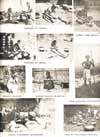The birth of a renowned scholar
The son of a public figure and scholar Sir Muttu Coomaraswamy, he studied geology in England and when he returned to Ceylon in 1903, was appointed as head of the Mineralogical Survey. His dedicated work in the field earned him a D.Sc. from the London University. He was most concerned about the neglect of traditional arts and crafts and was very critical of borrowing western ideas and models ignoring the rich native culture. He published 'Mediaeval Sinhalese Art' in 1908 after returning to England. Having travelled widely in India, he established the India Society in London to create a better understanding of the art, culture and philosophy of the East, in the Western countries. Between 1910 and 1947 (the year he died) he wrote at least a dozen books on the oriental culture and Buddhism. He was honoured in Sri Lanka by re-naming 'Green Path', (Colombo 7), the road where the National Art Gallery is situated. It's now known as 'Ananda Coomaraswamy Mawatha'. 'Mediaeval Sinhalese Art' (1908) begins with a chapter of 'The Sinhalese People'. The lucidity of his writing can be seen in the opening paragraphs:
"The Sinhalese people are inhabitants of Ceylon, but not all the people are Sinhalese. The etymologically identical word 'Ceylonese', however, is used to describe all persons born in Ceylon, whether Sinhalese, Tamil, Eurasian or otherwise, except Europeans. The word Cingalese is an old-fashioned and less correct spelling of Sinhalese. Of the three and a half millions forming, in round numbers, the population of Ceylon, two and a third million are Sinhalese inhabiting the southern two-thirds of the island, and rather less than one million are Tamils, living mostly in the north, on the east coast, and in Colombo. The remaining population consists of Moormen (Muhammmedans of Tamil extraction for the most part), Burghers (mixed descendants of Dutch settlers), Malays, Eurasians, Europeans and a few others. Of the influence exerted by these people on Sinhalese art, we need to consider only the Tamil; for on the one hand, Ceylon lies outside the range of Muhammedan conquests and influence, and for the rest, we must carefully avoid the manifestations of European influence if we are to see Sinhalese art at its best and purest. Fortunately, in the 18th century this influence had scarcely at all affected the art of the Kandyan province, although well marked in the low-country. "Almost the earliest Indian tradition of Ceylon is found in the Ramayana, the beautiful and romantic love story, which has for so long been to India all and more than was the tale of Troy to Greece, or Volsunga to the Scandinavians. It relates the capture of Sita, a queen of Northern India, by Ravana, the lord of Lanka (Ceylon); and the invasion of Ceylon by Rama, aided by his brother Laksman and by Hanuman and his monkey army.; the defeat of Ravana, and recovery of Sita. Lanka is also mentioned in the Mahabharata. "Another reference to Lanka is found in the Skanda Purana, the story of a great and malignant demon, for whose overthrow Skanda or Kartikeya was incarnated as a god of war and wisdom. This Kartikeya is still revered, particularly at his shrine at Kataragama in the feverish forests of the south-east of Ceylon, where pilgrims resort even the distant parts of India; Kataragama Deviyo, as he is generally known, was the patron god of Elala; and many devales dedicated to this god are found elsewhere, although the one just referred to is of peculiar sanctity".
The Postcard arrives The postcard, a convenient way of sending a message by post, was introduced to this country on August 22, 1872. It was cheaper to send a postcard than sending a letter. When the postage rate was six cents, the postcard cost three cents - exactly half. And that was the era when one cent coins were available in plenty. The postcard was introduced 15 years after the issue of the first postage stamp in Ceylon. The 6d (the currency then were pence & shillings) stamp was released on April 1, 1857. That was the letter rate to England by ship for half-ounce letters. By the time the postcard was issued, a decimal currency (rupees and cents) had been adopted. That too happened in 1872.
|
||||
Copyright © 2006 Wijeya Newspapers
Ltd. All rights reserved. |
 This
week commemorates the birth of a Sri Lankan who gained international
recognition as an authority on Asian art and culture. He is Ananda
K. Coomaraswamy, the renowned author best known for his work, 'Mediaeval
Sinhalese Art'. He was born on 22 August 1877. It is a classic work
on the crafts of Sri Lanka and serves as an authoritative reference
book. The well researched book is profusely illustrated.
This
week commemorates the birth of a Sri Lankan who gained international
recognition as an authority on Asian art and culture. He is Ananda
K. Coomaraswamy, the renowned author best known for his work, 'Mediaeval
Sinhalese Art'. He was born on 22 August 1877. It is a classic work
on the crafts of Sri Lanka and serves as an authoritative reference
book. The well researched book is profusely illustrated.